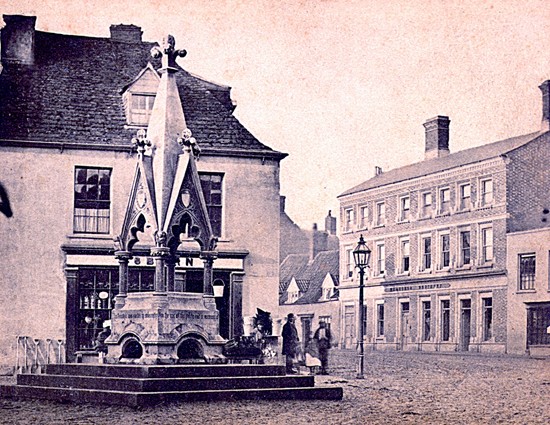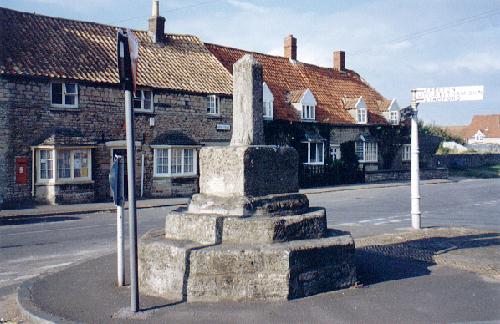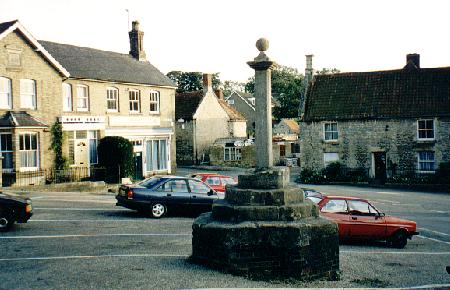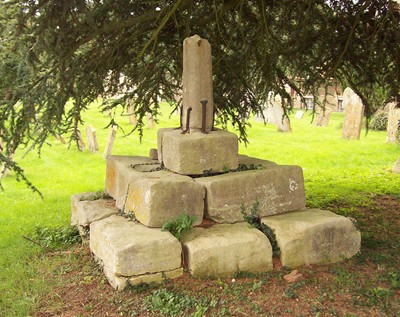|
When the market cross
was the centre of activity
The market cross was a feature of
most towns and villages in times past, a place to meet and gossip and
around which traders gathered on market days to hawk their wares, eggs,
butter, cheese and milk, fruit and vegetables, poultry, meat and fish,
cloth and basket work, food and goods that were produced in and around the
home or farm and brought in for sale to supplement the family income.
Hence the name butter cross and many survive as a marker for the old
market squares that have virtually been taken over by modern traffic,
usually in the form of spires, obelisks or crosses, although sometimes as
fountains, but usually with steps.
Bourne too had its own market cross, situated in the market place where
two main roads intersect and now known as the town centre. It was first
referred to in 1586 by the historian William Camden (1551-1623) who
visited the town while writing Britannia, his survey of the British Isles,
in which he described it as being ten feet high on an octagonal base with
three steps, and although it seems certain that it was simply a market
cross, he suggested that it had been erected to commemorate a battle and
added: "It was a place of sanctuary, and around it worship was wont to be
held."
A more detailed description survives from John Moore, one of our earliest
historians, who published an account of the town in February 1809 at the
instigation of his patron, Mrs Eleanor Pochin, tenant of the Abbey House
(now demolished) and widow of George Pochin who had been Lord of the Manor
of Bourne Abbots for 37 years until his death in 1798. Moore did not think
much of the town because he wrote: “Bourne in its present state is low and
meanly built and though the town is large and well situated, the market is
but indifferently attended.”
He then went on to describe the market cross: “On the west side of the
market place formerly stood the cross, the shaft of which was octangular
and elegantly formed, and stood upon a deep basement, ascended by three
steps. The shaft was ten feet in height, out of which grew an ash tree,
but both the shaft and tree are now removed.”
Moore then quotes Camden in greater detail, telling us that the cross
appears to be “the same cross as was commonly worshiped by ye parishioners
at other towns in Kesteven” and added: “These crosses, many of which still
remain in various parts of the kingdom, were erected, some of them for
boundaries of property, parishes and sanctuary, and others commemorated
battles, murders and other fatal occurrences. But they were principally
intended for devotional purposes and are commonly seen near churches, or
in the crossways leading thereto, where they were undoubtedly regarded
with idolatrous adoration. The cross lately destroyed in Bourne was built
with the ruins of the basement of a nearby building and placed on the
market place but of this there now only remains a heap of loose stones and
earth.”
The market cross also provided a central point for the community, a place
where villagers gathered to meet and to talk and to discuss the momentous
events at both local and national level that affected their lives because
they realised, as we do today, that there is a security in being with your
neighbours in times of crisis and an unspoken fellowship when there is
cause for celebration. The annual May statute fairs for the hiring of
servants were also held here and proclamations of important local and
national events were made from this spot.
Visiting monks and priests preached the word of God, and John Wesley, the
evangelist and founder of the Methodist movement, is supposed to have
visited Bourne in 1782 when he addressed townspeople from the steps of the
market cross after the parish clergy had closed their pulpits to him. This
incident is recounted in great detail by prominent local farmer Henry
Andrews Sneath (1860-1931), political and religious stalwart and author of
the book Methodist Memories, although it has been claimed that the story
is apocryphal.

The market cross in Bourne is known to have
survived until 1803 although its fate after that is unknown. A much later
feature of the market place was the Ostler memorial fountain, erected in
1860 in memory of a local benefactor John Lely Ostler (1811-59) and which
acted as a market cross for the next hundred years because this was the
centrepiece of many local celebrations such as Queen Victoria’s Diamond
Jubilee in 1897, the Relief of Mafeking in 1900 and the ending of the Boer
War two years later, peace proclamations for the Great War in 1918 and the
Second World War in 1945.
But that too was overtaken by progress and in 1960, Bourne Urban District
Council which then controlled local affairs decided that because of
increasing vehicle flows it was causing a traffic hazard and so it was
dismantled and moved stone by stone to the town cemetery in South Road
where it was re-erected and now awaits restoration after being protected
with a Grade II listing last year.
But we have to look a little further afield to find examples of market
crosses that have survived such as that which originally existed in Bourne
and the nearest example can be found at Swinstead, five miles west of the
town, standing on high steps in the main street. An earlier edifice can be
found at Corby Glen, erected during the reign of Edward III (1312-77), a
more elaborate design but then the village once had the status of a small
market town.
The market cross that once stood in the middle of Edenham, three miles to
the north west, also survives but not in its original position in the
centre of the village, having been removed to the churchyard after the
stonework was endangered by passing lorries and now rests underneath one
of the cedar trees near the main entrance to the church of St Michael’s
and All Angels.
See also The solitary
horseman
Return to
The Market Place

Go to:
Main Index Villages
Index
|



